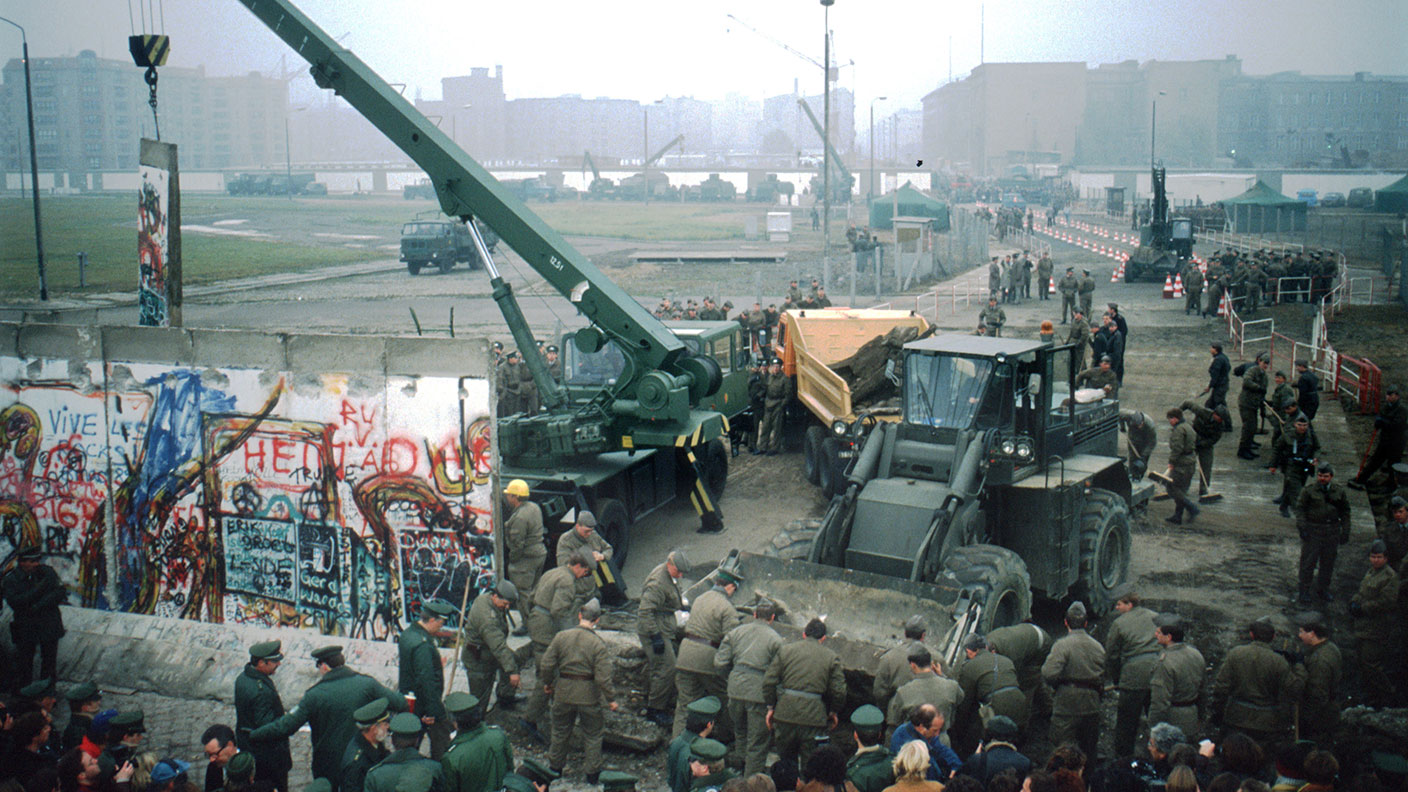9 November 1989: the fall of the Berlin Wall
On this day in 1989, thousands of East German citizens flooded over the border between East and West as the Berlin Wall fell.

When the world split into East and West after the Second World War, Berlin became an anomaly. Split into four sectors, it was run jointly by the USSR and the Western powers. Crossing between the various zones was easy, and, once in a Western zone, East Berliners were able to emigrate unhindered. And until 1961, over three and a half million had done just that.
Eventually, as tensions between West and East increased, the East German regime decided to act. So, virtually overnight on 13 August 1961, it threw up the “Anti-Fascist Protection Rampart”, AKA the Berlin Wall. Officially, the wall was built to protect the pure-minded citizens of the East from being corrupted by the lies and decadence of the West. In reality, it served to imprison them.
By the time it was complete, two million tonnes of concrete had been poured and 700,000 tonnes of steel used in its construction. Armed guards, tripwires, anti-tank traps and vicious guard dogs made sure nobody could approach. But even so, over the lifetime of the wall, 5,000 people tried to escape up to 200 are believed to have died in their attempts.
MoneyWeek
Subscribe to MoneyWeek today and get your first six magazine issues absolutely FREE

Sign up to Money Morning
Don't miss the latest investment and personal finances news, market analysis, plus money-saving tips with our free twice-daily newsletter
Don't miss the latest investment and personal finances news, market analysis, plus money-saving tips with our free twice-daily newsletter
It became a potent symbol of the Cold War; a backdrop for spy thrillers and presidential grandstanding. Many people thought it would become a permanent feature.
But towards the end of the 1980s, cracks began to appear in the Communist bloc. Political change was under way in Poland. And in Hungary, the Pan European Picnic saw thousands cross the border into Austria.
Emboldened by these events, East Germans began protesting. And on this day in 1989, the East German government announced it was to allow its citizens to cross the border. Thousands of them streamed over on foot and in their Trabants. West Germans flocked to the wall to greet them, and began to rip sections down.
The official demolition didn't get under way until the following summer, and it wasn't until 1992 that it had been completely dismantled.
After days of mass protest, the East German government announced on 9 November 1989 that all East German citizens could visit West Germany and West Berlin.
Get the latest financial news, insights and expert analysis from our award-winning MoneyWeek team, to help you understand what really matters when it comes to your finances.
Ben studied modern languages at London University's Queen Mary College. After dabbling unhappily in local government finance for a while, he went to work for The Scotsman newspaper in Edinburgh. The launch of the paper's website, scotsman.com, in the early years of the dotcom craze, saw Ben move online to manage the Business and Motors channels before becoming deputy editor with responsibility for all aspects of online production for The Scotsman, Scotland on Sunday and the Edinburgh Evening News websites, along with the papers' Edinburgh Festivals website.
Ben joined MoneyWeek as website editor in 2008, just as the Great Financial Crisis was brewing. He has written extensively for the website and magazine, with a particular emphasis on alternative finance and fintech, including blockchain and bitcoin.
As an early adopter of bitcoin, Ben bought when the price was under $200, but went on to spend it all on foolish fripperies.
-
 London claims victory in the Brexit wars
London claims victory in the Brexit warsOpinion JPMorgan Chase's decision to build a new headquarters in London is a huge vote of confidence and a sign that the City will remain Europe's key financial hub
-
 Rachel Reeves's Autumn Budget: What it means for the UK
Rachel Reeves's Autumn Budget: What it means for the UKOpinion A directionless and floundering government has ducked the hard choices at the Autumn Budget, says Simon Wilson
-
 31 August 1957: the Federation of Malaya declares independence from the UK
31 August 1957: the Federation of Malaya declares independence from the UKFeatures On this day in 1957, after ten years of preparation, the Federation of Malaya became an independent nation.
-
 13 April 1960: the first satellite navigation system is launched
13 April 1960: the first satellite navigation system is launchedFeatures On this day in 1960, Nasa sent the Transit 1B satellite into orbit to provide positioning for the US Navy’s fleet of Polaris ballistic missile submarines.
-
 9 April 1838: National Gallery opens in Trafalgar Square
9 April 1838: National Gallery opens in Trafalgar SquareFeatures On this day in 1838, William Wilkins’ new National Gallery building in Trafalgar Square opened to the public.
-
3 March 1962: British Antarctic Territory is created
Features On this day in 1962, Britain formed the British Antarctic Territory administered from the Falkland Islands.
-
10 March 2000: the dotcom bubble peaks
Features Tech mania fanned by the dawning of the internet age inflated the dotcom bubble to maximum extent, on this day in 2000.
-
9 March 1776: Adam Smith publishes 'The Wealth of Nations'
Features On this day in 1776, Adam Smith, the “father of modern economics”, published his hugely influential book The Wealth of Nations.
-
 8 March 1817: the New York Stock Exchange is formed
8 March 1817: the New York Stock Exchange is formedFeatures On this day in 1817, a group of brokers moved out of a New York coffee house to form what would become the biggest stock exchange in the world.
-
7 March 1969: Queen Elizabeth II officially opens the Victoria Line
Features On this day in 1969, Queen Elizabeth II took only her second trip on the tube to officially open the underground’s newest line – the Victoria Line.

